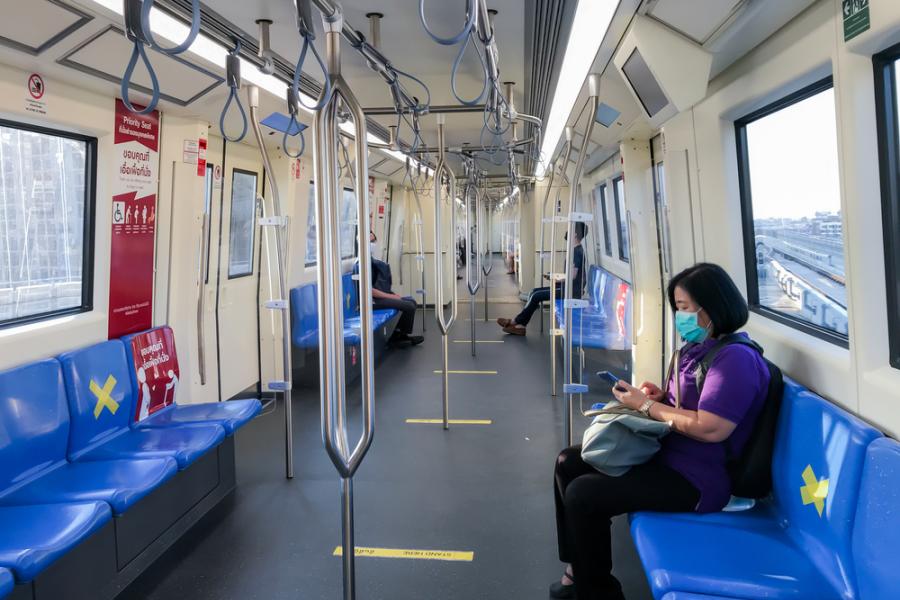By: Dr. Akhtar Nasim, Sr. Principal Scientist CSIR-CRRI & Prof. ACSIR (University) & Consulting Editor ICN Science & Tech
NEW DELHI: Public transport which includes buses and metro plays a major role in people’s mobility in urban and rural areas of India. Presently, around 10 cities are having operational metro network with a total network of more than 700 kilometers and about 525 metro stations. Similarly, more than 1.6 million buses are registered in India, and the public bus sector operates 170,000 buses carrying roughly 70 million people per day.
Social distancing or physical distancing, is keeping space between people to people outside of your home. Covid-19 spreads when an infected person coughs, sneezes, or talks, and droplets from their mouth or nose are launched into the air and land in the mouths or noses of people nearby. During the present prevailing COVID-19 pandemic situation, there may be high risk for commuters travelling by metro and bus and chances of spreading of virus are also very high. As recommended by the World Health Organization (WHO) and the Government Health Ministries recommended maintaining social distance of 6 feet to control the spread of the virus through person-to-person. In Delhi, more than 80 lakh trips are made by public transport i.e. Bus and Metro in a day. It’s always been a challenge to manage the gap between demand and supply of commuting. This gap is going to be further widened due to COVID-19 pandemic requiring the social distancing practices.
In view of this, a systematic and strategic approach is required to be adopted to move ahead during the COVID-19 pandemic. A gradual change in demand/ supply and adoption of circumstances by commuters is expected. The great challenge of both sides has to be dealt with carefully. At one side, it is expected that more commuters may prefer to travel by personalized vehicles (car and two wheelers) and on the other side, public transport capacity (fleet and frequencies). Multi dimensional approach is required to be adopted at every stage of public transport commuting. It must cover the walking from home to bus stop/ metro station, using feeder modes like cycle rickshaw, electric rickshaw, shared auto rickshaw etc., area of bus stop and metro stations and while travelling inside the bus and metro to reach destination. The ministry of health, government of India has adopted the guideline made by CSIR-CRRI. The glimpses of guideline are as follows:
- Bus or feeder bus services
Social distancing norms should also be followed in feeder buses. 60 feet bus should carry maximum of 18 riders (commuters) and 40 feet bus should carry only 12 riders. While traveling in bus, (i) maintain social distance, (ii) sit one person per seat and also diagonally with forward and backward seat commuter, (iii) do not stand in the bus and (iv) avoid touching of any surface in the bus. The seating arrangement should be as shown in the figure below.

Bus Stop and Surrounding Area:
- Plan your journey by watching the Bus apps/ and other public displays.
- Maintain minimum distance of 6ft (1.8m) with other commuters.
- Avoid touching of surfaces in the bus stops and also in the bus.
- Use proper hand hygiene methods such as gloves and hand sanitizers.
- Sit one person per seat and also diagonally with forward and backward seat commuter as shown in above photo.
- Commuters are not allow to stand inside bus or metro
- Metro Station & Surrounding Area
Subway/ Lift/ Escalator: Entry: commuters enter the metro station either through lift, subway staircase or escalators. They should avoid pressing the button of the lift as the lift is self operated and should also avoid holding the handrail of the escalators.
Double the dwell times: Since each coach shall carry only half of its capacity (i.e 25 commuters), it is envisaged that with the social distancing as well as alighting and boarding happening one after the other, the dwell time for each train service could be enhanced by 2 times the normal dwell time.
Queuing by commuters on platform: The commuters are expected to queue themselves as shown in figure at the platforms at the earmarked space for each commuter. The platform space for queue while waiting for transit service should be earmarked using a yellow retro-reflective tapes of size 1.8m X 1.8m.
Card scanning: Commuter should avoid touching tokens or card at the scanning machine, instead they should keep it at least 10mm above the scanning point. This will prevent transmission of virus from one token to another (in case any of the token is carrying the COVID-19).

Baggage Scanner/ Security Checkup: For scanning and security check-up, commuters must follow social distancing norms. Baggage scanning machine is the most unsafe place. If any single bag passing through has COVID-19 virus, then all other bags which follows would also get infected. Hence, before putting the bag inside the scanner, it is recommended to put the bag in a plastic bag or paper bag and this paper bag/ plastic bag should be removed just after scanning with proper safety.

Inside the train: The passengers should sit on alternate seats avoiding seats marked with ‘X’ marked tapes as shown in above figure. Within metro trains the commuters, on approaching their respective destination stations are advised to stand adjacent to their own seats and not to crowd in front of the exit gate so as to maintain social distancing and disembark such that the person nearest to the exit alights first.
- Auto / Electric Rickshaw / Taxi
Partition: Drivers are suggested to use Plastic sheet for physical separation between driver and commuter as well as within commuters in case of auto/ e- rickshaw/taxi.

- Footpaths
Pedestrians on road are large in number and spread all over the road network. However, there are roads with footpath as well as without footpath within the road network. On roads without footpaths, pedestrians do walk near the edge of roads. Social distancing in an area (footpath or area near edge of the road) can be guided by dividing the area with rectangles (boxes) for each person.





